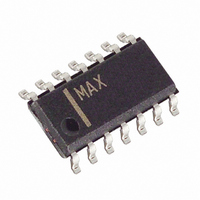MAX4386EESD+ Maxim Integrated Products, MAX4386EESD+ Datasheet - Page 10

MAX4386EESD+
Manufacturer Part Number
MAX4386EESD+
Description
IC OP AMP R-R SNGL 14-SOIC
Manufacturer
Maxim Integrated Products
Datasheet
1.MAX4386EESD.pdf
(13 pages)
Specifications of MAX4386EESD+
Applications
Voltage Feedback
Output Type
Rail-to-Rail
Number Of Circuits
4
-3db Bandwidth
230MHz
Slew Rate
450 V/µs
Current - Supply
5.5mA
Current - Output / Channel
55mA
Voltage - Supply, Single/dual (±)
4.5 V ~ 5.5 V
Mounting Type
Surface Mount
Package / Case
14-SOIC (0.154", 3.90mm Width)
Number Of Channels
4
Voltage Gain Db
63 dB
Common Mode Rejection Ratio (min)
70 dB
Input Offset Voltage
20 mV
Operating Supply Voltage
5 V
Maximum Power Dissipation
667 mW
Maximum Operating Temperature
+ 85 C
Mounting Style
SMD/SMT
Minimum Operating Temperature
- 40 C
Lead Free Status / RoHS Status
Lead free / RoHS Compliant
Low-Cost, 230MHz, Single/Quad Op Amps with
Rail-to-Rail Outputs and ±15kV ESD Protection
As with all Maxim devices, ESD protection structures
are incorporated on all pins to protect against ESD
encountered during handling and assembly. Input and
output pins of the MAX4385E/MAX4386E have extra
protection against static electricity. Maxim’s engineers
have developed state-of-the-art structures enabling
these pins to withstand ESD up to ±15kV without dam-
age when placed in the test circuit (Figure 6). The
MAX4385E/MAX4386E are characterized for protection
to the following limits:
• ±15kV using the Human Body Model
• ±8kV using the Contact Discharge method specified
• ±15kV using the Air-Gap Discharge method speci-
Figure 7 shows the Human Body Model, and Figure 8
shows the current waveform it generates when dis-
charged into a low impedance. This model consists of a
150pF capacitor charged to the ESD voltage of interest,
and then discharged into the test device through a
1.5kΩ resistor.
The IEC 1000-4-2 standard covers ESD testing and
performance of finished equipment; it does not specifi-
cally refer to ICs. The MAX4385E/MAX4386E enable the
design of equipment that meets the highest level (Level
4) of IEC 1000-4-2 without the need for additional ESD
protection components. The major difference between
tests done using the Human Body Model and IEC 1000-
4-2 is higher peak current in IEC 1000-4-2. Because
series resistance is lower in the IEC 1000-4-2 model,
the ESD-withstand voltage measured to this standard is
generally lower than that measured using the Human
Body. Figure 10 shows the IEC 1000-4-2 model and
Figure 9 shows the current waveform for the ±8kV IEC
1000-4-2 Level 4 ESD Contact Discharge test. The Air-
Gap test involves approaching the device with a
charged probe. The Contact Discharge method con-
nects the probe to the device before the probe is ener-
gized.
10
in IEC 1000-4-2
fied in IEC 1000-4-2
______________________________________________________________________________________
Human Body Model
ESD Protection
IEC 1000-4-2
Figure 7. Human Body ESD Model
Figure 8. Human Body Current Waveform
Figure 6. ESD Test Circuit
AMPERES
POINT A
TEST
VOLTAGE
SOURCE
HIGH-
DC
I
P
36.8%
100%
90%
10%
75Ω
0
0
CHARGE CURRENT
LIMIT RESISTOR
R
220Ω
C
= 1MΩ
t
RL
C
S
= 150pF
MAX438_E
220Ω
CURRENT WAVEFORM
TIME
5V
STORAGE
CAPACITOR
t
DL
DISCHARGE
RESISTANCE
V
R
D
EE
I r
= 1.5kΩ
C
2.2µF
BYPASS
PEAK-TO-PEAK RINGING
(NOT DRAWN TO SCALE)
75Ω
POINT B
TEST
DEVICE
UNDER
TEST











